先看需要实现的效果
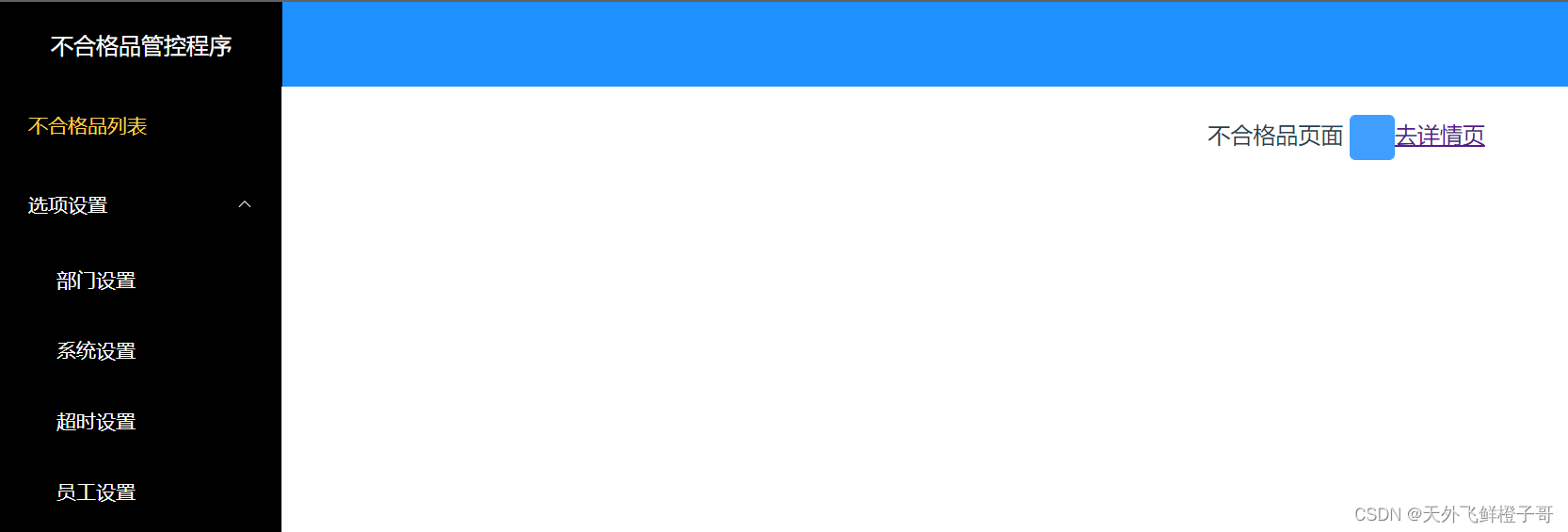
这里有一级也有二级菜单,注意二级菜单的父目录(”选项设置“点击不会跳转,只是展开目录),然后点击去详情页,需要跳到一个隐藏的路由,不在菜单展示的路由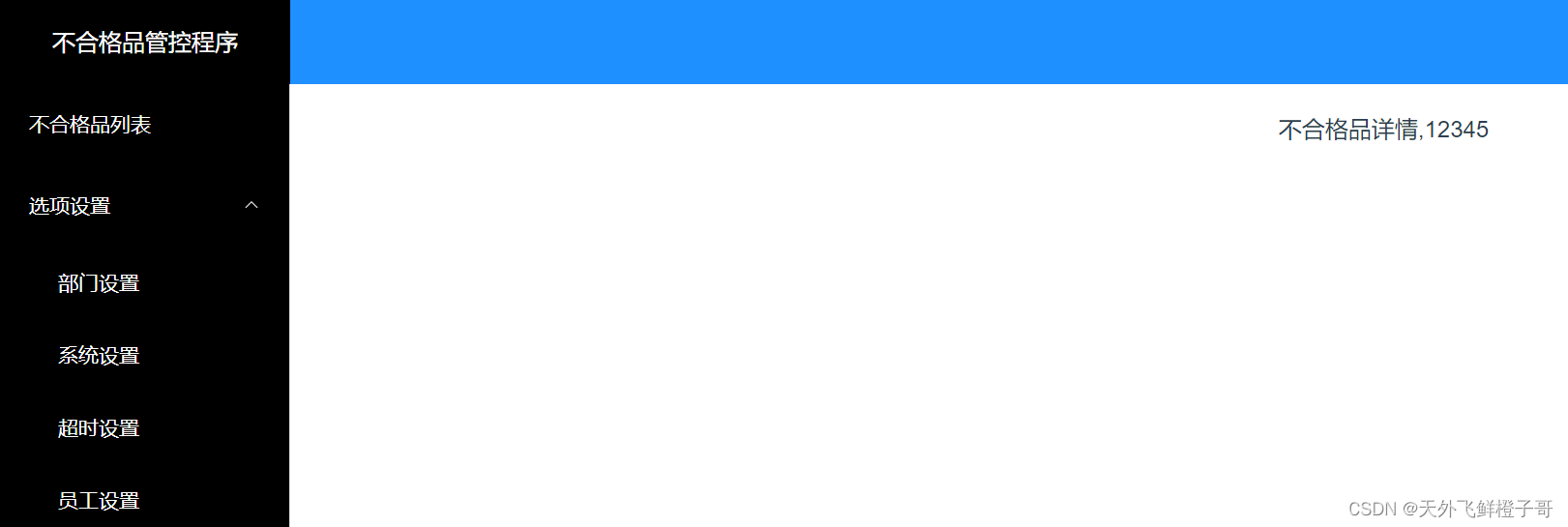
还有一点要注意,就是这里有两个router-view,整个页面是一个router-view,可以由LoginView和HomeView替换(当前看到的页面),而HomeView下又有一个router-view,需要用来展示部门,系统,超时,员工设置,不合格品列表和不合格品详情页。
以上的信息均需要在数据库的表中体现
先看看直接写在代码里需要哪些操作
const routes =[{path:'',name:'login',component: LoginView,},{component: HomeView,children:[{path:'/home',name:'不合格品列表',component: BelowStandard
},{path:'/product/:id',name:'不合格品详情',component: BelowStandardDetail
}]},{component: HomeView,name:'选项设置',children:[{path:'/employee',name:'员工设置',component: EmployeeConfig,},{path:'/department',name:'部门设置',component: DepartmentConfig
},{path:'/system',name:'系统设置',component: SystemConfig
},{path:'/warn',name:'超时提醒',component: WarmConfig
}]},{component: HomeView,children:[{path:'/statistics',name:'统计',component: DailyStatistics
}]},{component: HomeView,children:[{path:'/log',name:'日志管理',component: LogManager
}]},]
这是路由,当要动态从数据库加载时,就不能写在这
<el-menu
router
active-text-color="#ffd04b"
background-color="#000"class="el-menu-vertical-demo":default-active="this.$route.path"
text-color="#fff"
@open=""
@close=""><el-menu-item index="/home"><template #title>
不合格品列表
</template></el-menu-item><el-sub-menu index="/subMenuConfig"><template #title>
选项设置
</template><el-menu-item index="/department">部门设置</el-menu-item><el-menu-item index="/system">系统设置</el-menu-item><el-menu-item index="/warn">超时设置</el-menu-item><el-menu-item index="/employee">员工设置</el-menu-item></el-sub-menu><el-menu-item index="/statistics"><span>统计</span></el-menu-item><el-menu-item index="/log"><span>日志管理</span></el-menu-item></el-menu>
这是el-menu开启了路由功能,所以能跳转路由,当动态加载的时候,这部分需要改造成v-for
数据库

说明:parent_id为0的即是一级目录,但是一级目录里一部分可以直接展示界面,一部分是展开二级目录,我这是以component字段为home/HomeView.vue来区分是展示二级目录。
现在开始写后端程序,返回菜单的json格式数据。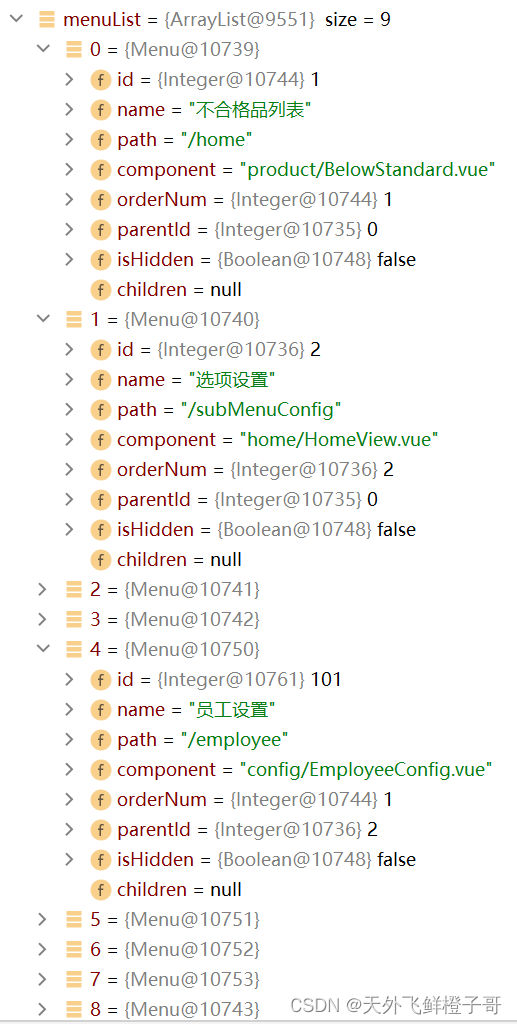
List<Menu> menuList = menuMapper.getMenuByUserId(UserUtils.getLoginUser().getId());//根据ParentId分组Map<Integer,List<Menu>> map = menuList.stream().collect(Collectors.groupingBy(Menu::getParentId,TreeMap::new,Collectors.toList()));List<Menu> menus = map.get(0);//一级菜单
menus.forEach(menu->{//给有二级菜单的目录设置children属性List<Menu> children = map.get(menu.getId());
menu.setChildren(children);});return menus;
从数据库查询到的数据格式如图,然后分一级二级菜单处理后,再返回前端
[
{
"name": "不合格品列表",
"path": "/home",
"component": "product/BelowStandard.vue",
"orderNum": 1,
"parentId": 0,
"isHidden": false,
"children": null
},
{
"name": "选项设置",
"path": "/subMenuConfig",
"component": "home/HomeView.vue",
"orderNum": 2,
"parentId": 0,
"isHidden": false,
"children": [
{
"name": "员工设置",
"path": "/employee",
"component": "config/EmployeeConfig.vue",
"orderNum": 1,
"parentId": 2,
"isHidden": false,
"children": null
},
{
"name": "部门设置",
"path": "/department",
"component": "config/DepartmentConfig.vue",
"orderNum": 2,
"parentId": 2,
"isHidden": false,
"children": null
},
{
"name": "系统设置",
"path": "/system",
"component": "config/SystemConfig.vue",
"orderNum": 3,
"parentId": 2,
"isHidden": false,
"children": null
},
{
"name": "超时提醒",
"path": "/warn",
"component": "config/WarmConfig.vue",
"orderNum": 4,
"parentId": 2,
"isHidden": false,
"children": null
}
]
},
{
"name": "统计",
"path": "/statistics",
"component": "statistics/DailyStatistics.vue",
"orderNum": 3,
"parentId": 0,
"isHidden": false,
"children": null
},
{
"name": "日志管理",
"path": "/log",
"component": "log/LogManager.vue",
"orderNum": 4,
"parentId": 0,
"isHidden": false,
"children": null
},
{
"name": "不合格品详情",
"path": "/product/:id",
"component": "product/BelowStandardDetail.vue",
"orderNum": 5,
"parentId": 0,
"isHidden": true,
"children": null
}
]
前端得到数据之后进行处理,再添加到路由,过程中遇到一个问题,vue-router4版本去掉addRoutes换成addRoute带来的问题困扰我很久,详情可以查看另一篇笔记:
第一次push路由不匹配
初始化路由:
router.beforeEach((to, from, next)=>{//配置路由守卫if(to.path==='/'){next()}elseif(store.state.user.id){initMenus(router,store,next,to)}else{next({path:'/',query:{redirect: to.path}});}});exportconstinitMenus=(router, store,next,to)=>{//按F5刷新的话vuex里的会被清空,长度变为0if(store.state.menu !==null){next()}else{
axios.get("/menu").then(response=>{if(response){let responseData = response.data
if(responseData.flag){
store.state.menu = responseData.data
initRoute(router,store.state)next({...to,replace:true})//解决router4版本的第一次路由不匹配问题}else{this.$ElMessage.error('请求菜单失败')}}})}}constinitRoute=(router,state)=>{constloadView=view=>{//这种引入方式控制台不会报警告// 路由懒加载return()=>import(`@/views/${view}`)};const menus = state.menu
const firstLevelMenu ={children:[],component:loadView('home/HomeView.vue')}
menus.forEach(menu=>{
menu.component =loadView(menu.component)if(menu.children ===null|| menu.children.length ===0){
firstLevelMenu.children.push(menu)}else{
menu.children.forEach(children=>{
children.component =loadView(children.component)})
router.addRoute(menu)}})
router.addRoute(firstLevelMenu)}
完成这些配置之后,路由就能动态加载了,然后取出vuex中存储的menu生成el-menu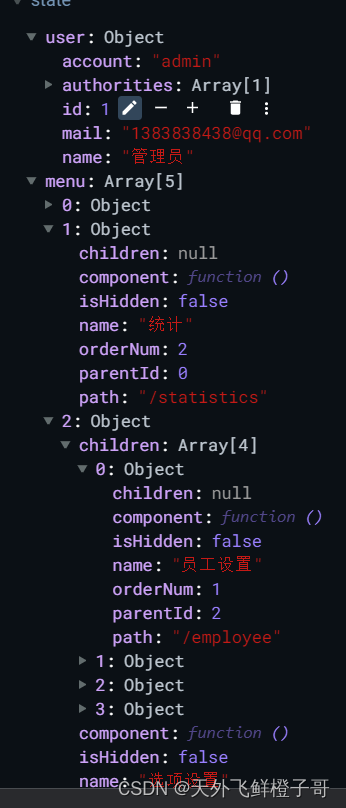
vuex中菜单大致如图
<el-menurouteractive-text-color="#ffd04b"background-color="#000"class="el-menu-vertical-demo":default-active="this.$route.path"text-color="#fff"@open=""@close=""><templatev-for="route of this.$store.state.menu"><templatev-if="route.children === null || route.children.length === 0"><!--一级菜单--><templatev-if="!route.isHidden"><el-menu-item:index="route.path"><span>{{route.name}}</span></el-menu-item></template></template><templatev-else><!--二级菜单--><templatev-if="!route.isHidden"><el-sub-menu:index="route.path"><template#title><span>{{route.name}}</span></template><templatev-for="children of route.children"><templatev-if="!children.isHidden"><el-menu-item:index="children.path"><span>{{children.name}}</span></el-menu-item></template></template></el-sub-menu></template></template></template></el-menu>
实现效果展示
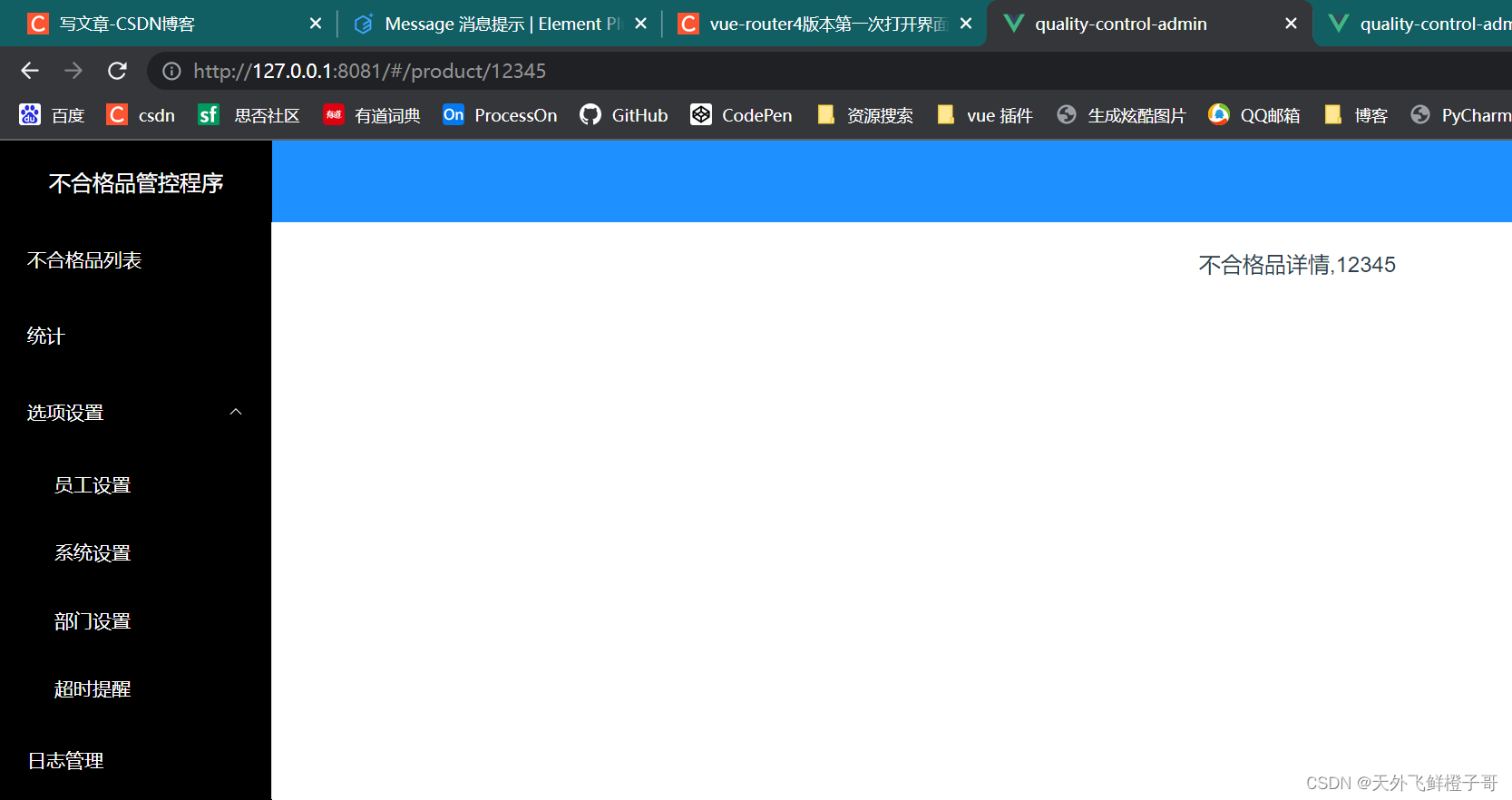
版权归原作者 天外飞鲜橙子哥 所有, 如有侵权,请联系我们删除。